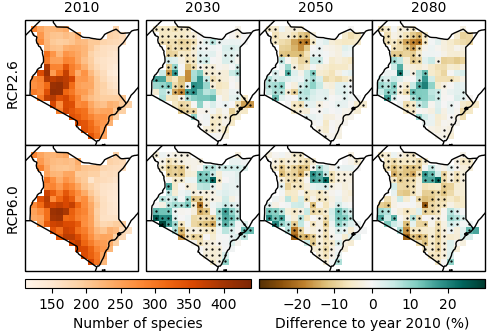Kenya: Ecosystems
Climate change is expected to have a significant influence on the ecology and distribution of tropical ecosystems, even though the magnitude, rate and direction of these changes are uncertain [28]. With rising temperatures and increased frequency and intensity of droughts, wetlands and riverine systems are increasingly at risk of being converted to other ecosystems, with plant populations being succeeded and animals losing habitats. Increased temperatures and droughts can also affect succession in forest systems while concurrently increasing the risk of invasive species, all of which affect ecosystems. In addition to these climate drivers, low agricultural production and population growth might motivate further agricultural expansion resulting in increased deforestation, land degradation and forest fires, all of which will impact animal and plant biodiversity.
Species richness

Model projections of species richness (including amphibians, birds and mammals) and tree cover for Kenya are shown in Figure 16 and 17, respectively. Projections of the number of animal species vary depending on the region and scenario (Figure 16). Since every species reacts differently to climate impacts, some areas in Kenya are projected to gain in the number of animal species, while other areas are projected to lose animal species due to climate change. The locations of projected changes shift from RCP2.6 to RCP6.0 with higher certainty under the latter. Nevertheless, a clear picture cannot be drawn.
Tree cover

With regard to tree cover, model results are clearer and more certain, especially for RCP6.0 and after 2050: Median model projections agree on an increase of tree cover by up to 9 % in south-eastern Kenya (Figure 17). This increase can be explained by the increasing precipitation levels which are projected in this region.
Although these results paint a rather positive picture for climate change impacts on tree cover, it is important to keep in mind that the model projections exclude any impacts on biodiversity loss from human activities such as land use, which have been responsible for significant losses of global biodiversity in the past, and which are expected to remain its main driver in the future [29].
References
[28] T. M. Shanahan, K. A. Hughen, N. P. McKay, J. T. Overpeck, C. A. Scholz, W. D. Gosling, C. S. Miller, J. A. Peck, J. W. King, and C. W. Heil, “CO2 and Fire Influence Tropical Ecosystem Stability in Response to Climate Change,” Nat. Publ. Gr., no. July, pp. 1–8, 2016.
[29] IPBES, “Report of the Plenary of the Intergovernmental Science-Policy Platform on Biodiversity and Ecosystem Services on the Work of Its Seventh Session,” n.p., 2019.


